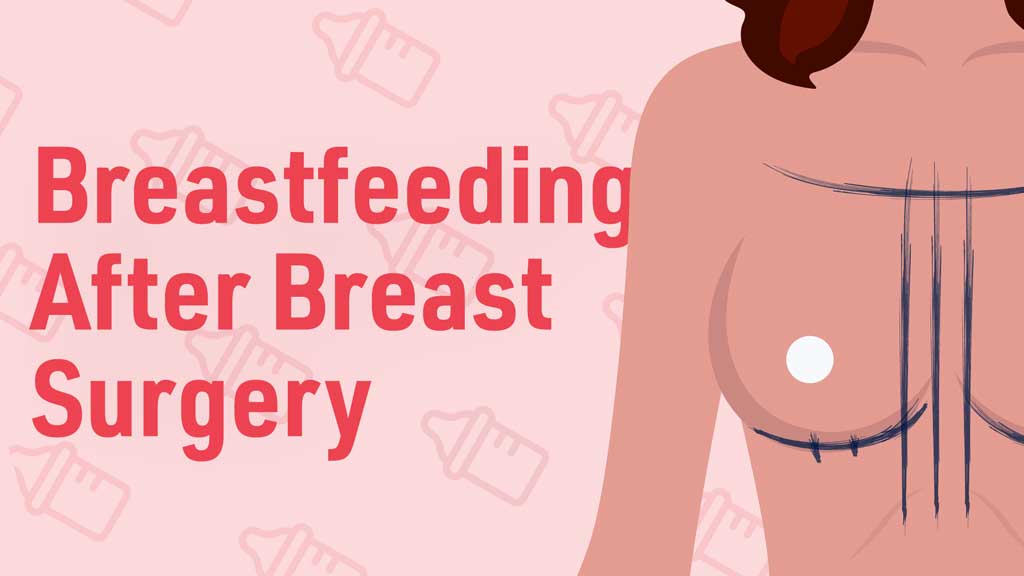People who have undergone breast surgery are naturally concerned about how the procedure might impact their ability to breastfeed.
A compassionate, well-informed approach from postnatal carers can make all the difference to the success - or failure - of breastfeeding following surgery.
Breast Augmentation
Augmentation mammoplasty is a surgical procedure that increases the size of the breast by inserting implants under the breast tissue or chest muscles. It is one of the most common cosmetic surgery procedures in Australia (ACSQHC 2023).
It’s usually possible for people with breast implants to breastfeed successfully, but this can depend on many factors affecting the milk supply. For example:
- The type of surgery performed and the amount of damage to nerves or breast tissue
- The location of the surgical incision
- The presence of scarring in the milk ducts
- How much functional milk-producing glandular tissue is present both before and after the procedure.
(Pearson-Glaze 2020)
Position and Size of the Implant

Both the location and placement of the surgical incision can directly affect the ability to produce milk postnatally. For example, an incision around the areola or across a portion of it can reduce the nerve response needed for the let-down reflex to function properly. Equally important is the position of the implant, which may cause reduced milk production and flow if too much pressure is placed on the glandular tissue (BFAR 2016).
Additional factors that can reduce the success rate of breastfeeding with implants include:
- The size of the implant: Larger implants tend to be associated with less nipple sensitivity and could put more pressure on the milk-producing glands.
- The presence of scar tissue: Scarring following surgery may contribute to distortion and pain as well as inhibit the milk supply.
- Excessive engorgement: People with implants may be more prone to excessive engorgement if the milk can’t drain freely from the breast.
- Increased sensitivity: Following implant surgery, some people experience increased sensitivity, making touch painful.
- Nipple vasospasm: Surgery involving the nipple can result in a painful burning sensation, making feeding painful. Numbness of the nipple due to damaged nerves can also inhibit the stimulation needed for milk production.
- Lack of functional residual breast tissue: Where implants are used to correct abnormal breast development, there may be an underlying lack of functioning breast tissue.
(Pearson-Glaze 2020)
Sadly, many people are not well-advised about potential postnatal problems surrounding breastfeeding. Yet, despite these difficulties, the glandular tissue of the breast naturally continues to develop under the influence of pregnancy and breastfeeding hormones. The remaining areas of the breast that are functioning normally can also help to compensate for damaged areas.
A study by Davanzo (2018) found that women who had undergone breast augmentation experienced no differences in attempting to breastfeed, but overall, they had a lower rate of breastfeeding at discharge and a lower rate of exclusive breastfeeding at one month postnatally.
This is why it’s so important for the maternity care team to identify those who have undergone breast augmentation surgery so that extra help and support can be given to establish successful feeding routines (Roberts et al. 2015).
Breast Reduction Surgery
Breast reduction surgery can offer many psychological and physical benefits, but it can also impair breastfeeding if too much functional glandular tissue has been removed or if the nipple is moved to a new position during surgery. With time, however, some regrowth of the nerve supply is possible, and the remaining glandular tissue can still develop during pregnancy (Australian Breastfeeding Association 2022).
Kraut et al. (2017) conducted research to evaluate how breast reduction surgery impacts breastfeeding success - in particular, whether different surgical techniques impact breastfeeding success in different ways. They found that techniques that preserve the column of subareolar parenchyma appear to have a greater likelihood of success, and they suggest that patients should be counselled about the importance of preservation of the column of subareolar parenchyma prior to surgery.
Davanzo (2018) also explored this topic and conducted a systematic review of 51 observational studies on the impact of breast reduction surgery on breastfeeding success. Results of this research also confirmed that preservation of the subareolar parenchyma, from the nipple-areola complex to the chest wall, was essential for successful breastfeeding. By contrast, when the subareolar parenchyma was not preserved, only 4% of people could be expected to breastfeed successfully. Preservation of the fourth intercostal nerve is also important as this plays a vital role in triggering the release of prolactin and oxytocin.
Additional factors that influence successful breastfeeding after breast reduction include:
- The amount of time that has passed since the surgery: Over time, damaged nerves can reconnect with an average growth rate of 1 mm per month, restoring normal sensitivity.
- Healing of milk ducts: With time, severed ducts can make new connections to the nipple, and the ability of the breast to make milk may improve.
- New glandular tissue can develop and be stimulated by the hormones of the menstrual cycle and pregnancy.
- Breastfeeding itself also stimulates further recovery, however, this is dependent on how many milk ducts remain within the breast.
(Pearson-Glaze 2020)

Breastfeeding may also be possible for those who have had a full or partial mastectomy for breast cancer if they can breastfeed from the other breast, or if sufficient functional glandular tissue remains on the affected side (Australian Breastfeeding Association 2022).
However, many people are not adequately advised that a lack of glandular tissue through breast reduction surgery or the pressures placed on the milk-producing tissue through breast augmentation can reduce their ability to breastfeed (BFAR 2016).
Despite these challenges, Davanzo (2018) suggests that the support and attitude of the maternity team can significantly impact a person’s ability to breastfeed successfully. In particular, they suggest that failure to distinguish between a contraindication and an obstacle to feeding can be confusing to a new parent and that success, or failure, depends to a large extent on the support a parent receives in the early postnatal days.
Test Your Knowledge
Question 1 of 3
Which nerve plays an important role in stimulating milk production following breast surgery?
Topics
References
- Australian Breastfeeding Association 2022, Breastfeeding After Breast Surgery, Australian Breastfeeding Association, viewed 25 October 2024, https://www.breastfeeding.asn.au/bfinfo/breastfeeding-after-breast-surgery
- Australian Commission on Safety and Quality in Health Care 2023, Cosmetic Surgery in Australia, Australian Government, viewed 25 October 2024, https://www.safetyandquality.gov.au/sites/default/files/2023-12/media_infographic_cosmetic_surgery_standards.PDF
- BFAR 2016, Breastfeeding After Breast Augmentation Surgery, BFAR, viewed 25 October 2024, https://www.bfar.org/possible-augmentation.shtml
- Davanzo, R 2018, ‘Controversies in Breastfeeding’, Frontiers in Pediatrics, vol. 6, viewed 25 October 2024, https://www.frontiersin.org/articles/10.3389/fped.2018.00278/full
- Kraut, R, Brown, E, Korownyk, C et al. 2017, ‘The Impact of Breast Reduction Surgery on Breastfeeding: Systematic Review of Observational Studies’, PLOS ONE, vol. 12, no. 10, viewed 25 October 2024, https://journals.plos.org/plosone/article?id=10.1371/journal.pone.0186591
- Pearson-Glaze, P 2020, ‘Breast Reduction and Breastfeeding’, Special Circumstances, 21 April, viewed 2 October 2021, https://breastfeeding.support/breast-reduction-and-breastfeeding/
- Roberts, C, Ampt, A, Algert, C et al. 2015, ‘Reduced Breast Milk Feeding Subsequent to Cosmetic Breast Augmentation Surgery’, Medical Journal of Australia, vol. 202, no. 6, viewed 25 October 2024, https://onlinelibrary.wiley.com/doi/abs/10.5694/mja14.01386
 New
New 
